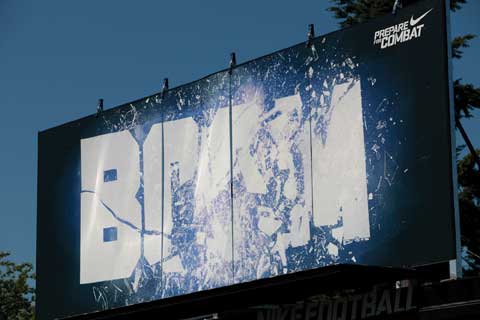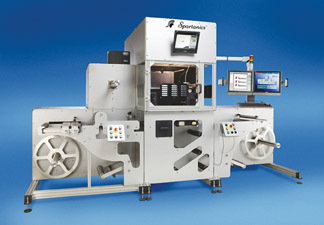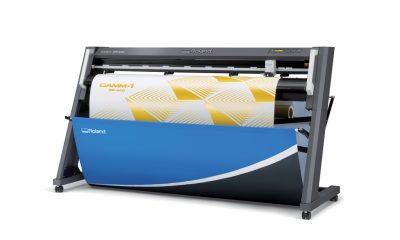Graphics Printing
Published
13 years agoon

What if you could expand your business and open doors to new markets? What if you had the ability to increase your margin per print 10 fold? What if you had the opportunity to partner with companies that produce work for brands like Nike? What would you say if all of these great things required you to venture outside of your comfort zone or product specialty?
What if you could expand your business and open doors to new markets? What if you had the ability to increase your margin per print 10 fold? What if you had the opportunity to partner with companies that produce work for brands like Nike? What would you say if all of these great things required you to venture outside of your comfort zone or product specialty?
If you don’t open yourself to the possibility, you could be missing out on a lot. Take my company, for example. Ryonet, does not screen print for profit—that is, we don’t print jobs for customers. Instead, we focus on educating and supplying screen printers. So, how did we end up printing a job (Figure 1) for a large-scale advertising campaign involving an international ad agency, a commercial design house, a high-end photography studio, and one of the most recognizable brands featuring various high-profile athletes—all with a profit of $25-30 per print? It was simple: by being open-minded and flexible. By stepping outside the world of T-shirts, Ryonet had the opportunity to screen print the core piece of a national advertising campaign that encompassed graphics screen printing, digital photography, digital printing, and—eventually—garment screen printing.
The background story
It all started on a late Friday afternoon in January of 2010. I received an urgent call from my good friend, Tyler. While we have known each other personally for years, Tyler has freelanced for Ryonet with various product-photography projects and professionally works as a commercial photographer at a high-profile photography studio in Portland, OR. As we talked that afternoon, the tone of desperation in Tyler’s voice told me he needed some help. He asked me, “Is it hard to screen print onto glass?” “That depends,” I said, “on how many colors are being used, the size of the prints, and the number of designs.”
He explained that the studio where he works had a project that needed one color printed on larger prints with five or six different designs totaling 10-12 pieces each. I knew what he was asking was possible and, although not easy, it could certainly be done. I offered to check with several Ryonet customers about getting the work printed for him. This is when Tyler revealed the real source of his desperation: “We’ve already called several printers. No one is willing to take on the job because it is more complicated and we need the finished product first thing Monday morning.”
Seeing as it was already late afternoon on Friday, I agreed that finding anyone to take this on would be next to impossible; there just weren’t enough hours left in the day. Then came his request: “That is why I was really calling. Do you think you could do it?” I thought, “Well, there goes my Sunday night,” and I decided to ask what client the job was for and if the budget had been established. It turned out that the campaign was for Nike and the working budget was $50-60 per print, including glass. I quickly decided that, yes, I would help Tyler out and that this was absolutely a job I wanted. It seemed like it would be a great learning experience and a strong highlight for the company’s printing resume. How hard could it really be? And BOOM! Just like that, I found myself involved in something really big and new.
It was almost midnight on Sunday when I discovered that this project was anything but simple. I saw the reasoning behind why so many printers had turned Tyler’s last-minute request down; screen printing on glass is not at all like screen printing on T-shirts (Figure 2). The ink I used had to be printed through 25 x 36-in. screens (230-thread/in. mesh) coated with a special, solvent-resistant emulsion. The glass had to be cleaned on both sides, registered, and stacked to air-dry for at least 12 hours. The real fun began after the screens were prepped, coated, and dried; the films were printed; stencils exposed; screens taped; off-contact set; and print registered. The gloss-enamel formulation I used is an air-curing ink and, by its apparent properties, this ink dries rather quickly in the screen. Combine that with a glassy surface and you’ve got yourself a completely different animal than a T-shirt.
In the middle of the project
After two hours into printing this project without any success—and with two bottles of screen opener used up—things finally started working. This is what I learned about screen printing on glass: Glass is slippery—especially after it’s cleaned. The ink I used is thick, and glass doesn’t receive ink all that well in the first place. When printing on glass, cleaning it first and then letting each piece dry and warm up before you attempt to print on it is crucial. Proper off-contact is also critical when printing on a slippery, rigid substrate. Because I was printing with large-format static frames, known for lower screen tension, I had to double my off-contact to almost 0.25 in.
I have always been told to thin enamel ink down to 2-3%. While this modification may work well for printing on metal or wood, it did not work well for glass. Most of the troubleshooting during the first few hours of testing focused around the consistency of the ink. If the ink is too thin, it will leave extremely messy and unacceptable edges. The text I printed was bold and linear, so it absolutely needed to be clean and precise. In the end, the key to the proper consistency was using the ink straight out of the can. This gave the most even and highest quality print possible, which was the formula I used repeatedly until the job was completed.
The unmodified ink dried much more quickly in the screen and took considerably longer to dry on the substrate surface. The thick ink also created some trouble with its tendency to dry in the screen, which lead to the image not printing properly on the glass. The solution was to move fast, keep the screen flooded, and print consistently. Once this all came together, I could print one about every 30 seconds. The job began to fly by. It was working, and the results were something I was really proud of. The glass dried overnight, and Tyler picked the finished pieces up in the morning to photograph. Mission accomplished.
I’ve described my printing process not to explain how to print on glass, but to show you the journey of the experience. The important detail is that I had the opportunity to print this job in the first place only because I was willing to try it. Many screen printers would shy away from trying new things and stepping outside of the box because with the new comes the unpredictable. Sure, it may a take a little time, quite possibly some trial and error, if the end result is a success, you’ve just separated yourself that much more from your competition. The screen printers I know who do this stay busy, expand their clientele, know more about printing, and have the ability to make much more money.
So ask yourself this: What is available outside the world of screen-printing T-shirts? I encourage you to consider my experience; it was a job contracted for Nike involving the ad campaign BOOM. This job started out as a concept in the creative minds at an ad agency and a commercial design house. They had an idea of BOOM and needed a way to show the expression of BOOM physically happening through text.
Here is the concept behind Nike’s BOOM as demonstrated by Media Bistro: Consider, if you will, boom replacing snap at the forefront of the American exclamatory lexicon. In other words, where a professional football player might say ‘boom’ after delivering a cranium-crushing blow to the opposing team’s quarterback. Rick Ross might say ‘boom’ after dropping about $1 million for extravagant jewelry designed to resemble his face. The average layperson, on the other hand, might say ‘boom’ after tossing a piece of trash into a garbage can 12 feet away, or after catching the bus right before it speeds off. Really, boom can apply to any situation.” (Visit www.mediatbistro.com/agencyspy/tag/rick-ross for more on this.)
How do you show all that in a format that translates seamlessly and beautifully into usable promotional products? Screen print it onto glass and have one of the best photography studios in the country photograph that glass breaking. Screen printing the glass was only one part of the BOOM equation. The studio went all out to achieve imagery that would capture the essence of BOOM as they envisioned it. They used a high-speed camera and a sound trigger to capture the explosion of glass as a high-powered slingshot catapulted a marble-like ball through the screen-printed surface (Figure 3). Now you can literally see the image going boom.
Once things were said and done, Tyler told me that it was one of the more fun and creatively challenging projects he had collaborated on in a while and then thanked me profusely for screen printing the glass. Imagine being thanked for getting paid $30 per print! I was happy and pleased that Ryonet had the opportunity to be involved. The image has been used in many facets of ad campaigns and promotional materials: posters, banners, P-O-P displays, billboards, and yes, even on T-shirts.
In conclusion
After the images were edited, Nike’s campaign ran with them and produced them in typical, larger-than-life fashion: a stadium-sized, digitally printed banner photographed at a local football stadium with Tyler and a colleague proudly showing off their work, and even the familiar warm and cozy territory so many screen-printers are comfortable with: printed apparel (Figure 4).
I wasn’t able to find out who digitally printed the stadium banner, but I did track down the company that screen-printed the T-shirts. I bumped into Kelly Simmons, the ink tech for Latitudes in Portland, OR, at a recent tradeshow in Long Beach, CA. Knowing that Latitudes is one of the printing companies Nike uses regularly, I asked him if the shop had printed any BOOM shirts last year. Kelly confirmed that Nike had done several short/medium runs through Latitudes around the BOOM campaign. As you can see, what was an elaborate and creative process turned out to be a fairly simple screen print on a T-shirt.
Sure, this is a larger-than-life example of how an ad campaign can combine multiple methods of printing in our industry, but the point I want to emphasize is that if you are able to become versatile in your company, you can take advantage of many markets. Screen and digital printing for non-apparels is many times larger than the T-shirt market. In addition to T-shirts you could screen print on glass, metal, wood, plastic, and much more.
Though it’s a small percentage, some of our overall customer base steps outside of T-shirts. As a result, they have been able to print distortion pedals and gear racks for rock stars and specialty P-O-P displays for companies such as Nike and Adidas (Figure 5) and even digitally print on banners for professional sports organizations (Figure 6).
The beauty of what waits outside the world of T-shirts is the fact that these jobs can potentially be the most fun, creative, and profitable for your business. Be ready and willing to learn, experiment, and invest and you, too, can open the door to new markets while increasing print-piece margins by more than 10 fold and maybe even print for companies like Nike.
Ryan Moor is the president and CEO of Ryonet Corporation of Vancouver, WA. The company’s main website is www.silkscreeningsupplies.com, which offers online supplies, support, and education. Ryan loves training and helping screen printers become successful.
Heather Ashlock is the editorial manager at Ryonet. She can be reached at hashlock@ryonet.com.
Combining Screen and Digital Printing
Randy Paar
Océ North America
The ability to mix traditional and digital printing technologies enables some unique benefits that would not exist if jobs were printed using just one technology. For instance, with variable data being printed on-demand, a screen printer can quickly and cost-effectively print the base graphics traditionally and then add whatever personalization as needed using a digital process. This keeps the cost per piece to a minimum yet opens up new opportunities in selling customized items. Another benefit is the full-color, photographic-like quality that can now be achieved through UV inkjet printing.
To get into this two-step workflow, screen printers will need to acquire a flatbed inkjet printer. For greatest versatility—and reduced labor and waste—they should select an inkjet architecture that uses a stationary vacuum table rather than a belt-driven hybrid design. This is similar to how many screen printers print conventionally: laying the substrate down on a vacuum table and positioning it with a three-point registration system. If they were to use a belt-driven transport there might be greater risk of mis-registration of the piece, and printing of non-square or rectangular items can be difficult—if not impossible. Another consideration is size in area and height. The more clearance a printer can offer between the print bed and printhead array, the more types of applications
it can handle.
Randy Paar has worked in the graphics industry for more than 30 years in a variety of capacities and technologies. He is currently based in Chicago and is Océ North America’s marketing manager for display graphics. He can be reached via email at randy.paar@oce.com.

Subscribe

Magazine
Get the most important news
and business ideas from Screenprinting Magazine.
Most Popular
-

 Case Studies2 months ago
Case Studies2 months agoHigh-Density Inks Help Specialty Printing Take Center Stage
-

 Art, Ad, or Alchemy2 months ago
Art, Ad, or Alchemy2 months agoF&I Printing Is Everywhere!
-

 Andy MacDougall2 months ago
Andy MacDougall2 months agoFunctional and Industrial Printing is EVERYWHERE!
-

 Columns3 weeks ago
Columns3 weeks ago8 Marketing Mistakes Not to Make When Promoting Your Screen Printing Services Online
-

 Editor's Note3 weeks ago
Editor's Note3 weeks agoLivin’ the High Life
-

 Marshall Atkinson3 weeks ago
Marshall Atkinson3 weeks agoHow to Create a Winning Culture in Your Screen-Printing Business
-

 Thomas Trimingham2 months ago
Thomas Trimingham2 months ago“Magic” Marketing for Screen Printing Shops
-

 Case Studies3 weeks ago
Case Studies3 weeks agoScreen Printing for Texture and Depth






